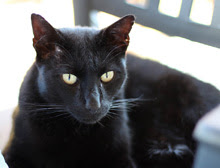And you thought the holidays were over? Ha!
The first Sunday after the first day of January is the epiphany for Catholics, the day they realize how silly the pope looks in those hats. Or something like that.
For French Catholics, it's the time of year to eat
galettes des rois, a
tarte made from
pâte feuilletée (puff pastry) and filled with
frangipane (almond paste). All the bakeries make several sizes and varieties of the
galette, and people (like us) will often buy several over the course of a couple weeks.
 The galette comes in a special bag for heating it up in the oven.
The galette comes in a special bag for heating it up in the oven.
There is small print on the bag that warns you to take the paper crown out before putting the bag in the oven.Hidden inside the
galette is what's called a
fève (literally: bean) that is typically a small ceramic
or plastic figurine. Tradition holds that revelers gather 'round the table when it's time to cut the
galette. The youngest member of the group gets under the table while the
tarte is cut and he or she decides who gets which piece. This avoids any hanky-panky in determining who gets the piece with the
fève inside.
 Our small, and not particularly special, collection of fèves from past galettes.
Our small, and not particularly special, collection of fèves from past galettes.The lucky person to bite down on the
fève wins, and gets a free trip to the dentist. I'm kidding about that part; it's not free. What the winner does get is a paper crown and the joy of being declared King for the Day. Imagine how many kings there are running around France this time of year. In addition to his other regal duties, the king is responsible for getting the next
galette.
 Our first galette of 2008 - not likely to be our last!
Our first galette of 2008 - not likely to be our last!Now, over the years, some people have carefully cleaned and saved their
fèves to the point of building huge collections. These people seek each other out to share and view their collections. There are shows where you can see the series of
fèves that represent the kings of France (some missing their heads), or Disney characters, or the original Broadway cast of "Hair." There are proud displays of rare and historic
fèves. There are
fève fairs where much buying and selling and trading of
fèves goes on. And, of course, there is the ever-present news media to provide us with the requisite human interest story on the evening news.
The people who engage in all of this are called
favophiles and they practice
favophilie. Sounds dirty, but it's not. Except for all that
frangipane on their fingers.
And there is no rest for the weary. As all this winds down and February approaches, we will get out our trusty
crêpe pans and mix up the batter for
la Chandeleur, another Catholic holiday celebrating the holy pancake.
 A spillway and lock (écluse) on the eastern bend of the Lot.
A spillway and lock (écluse) on the eastern bend of the Lot.





















































